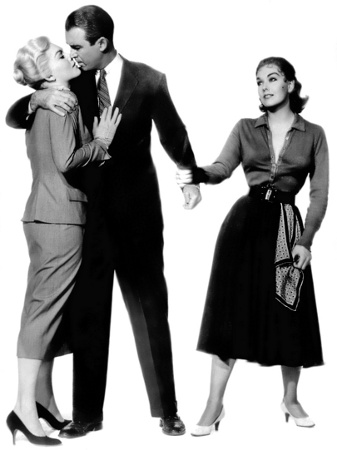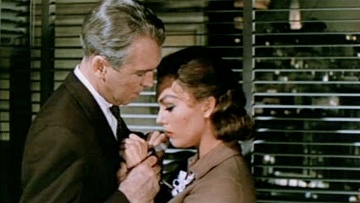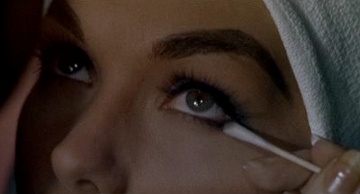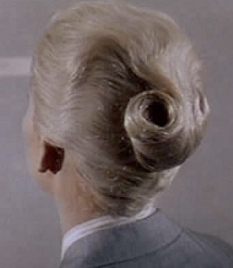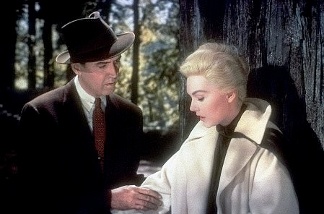Every piece of film that you put in a picture should have a purpose. You cannot put it together indiscriminately. It’s like notes of music. They must make their point.
I put first and foremost cinematic style before content…I don’t care what a film is about…Content is quite secondary to me. (Alfred Hitchcock)
Introduction
In Hitchcock’s films the clothing of an actor or actress is crucial to their fictional identity and, more important perhaps for Hitchcock, their mistaken identity (the wrong man). Simulation, doubling, resemblance, mirroring, fantasy are Hitchcock’s central concerns and all are connected to dress. Though actors in films by the fact of being characters are in masquerade – matters of clothing, gesture, dialogue, in short, characterisation – in Hitchcock’s films, masquerade, eroticism and deceit, as attached to clothing, hairdo, accessories, the sound of a voice, a gait, are structural and thematic, not a background, atmosphere, nor something extra, nor a banal detail, but always to the point and always significant. Hitchcock seldom wastes a shot and nothing in his films is gratuitous. Few characters in his films are what they appear to be and few of the narratives and the events that texture them are what they appear to be; on the contrary, they are simulations of reality, an essential unfaithfulness. It is not simply that in a Hitchcock film illusions are created, as in most films, but rather that such illusions and the fantasies they generate, are instrument and subject, what the characters do and what they perform. The interpretation by characters of others, of events, of objects, of themselves, of the appearance of things, and of surface reality, are their projections, their fashionings, a sign of their desires, as if, it is literally the characters who fashion and fabricate the narrative. The subject of the Hitchcock narrative is the creation of a narrative internal to it, like a double of itself.
Fashion, in the widest sense of fashioning, disguising, making and, in instances, remaking (Vertigo, To Catch a Thief) and making-believe (delusion, trickery), fabricating are the formal cloth of a Hitchcock film, its texture and weave. To that extent, his films are a reflection upon the illusions they create, the aspect that the film-makers of the French nouvelle vague (Rohmer, Chabrol, Rivette) focussed upon: not only the spectacle of an illusion but the consciousness of it, made conscious in part by a doubling, a scene constructed by the regard of the characters and entered into by the audience who are led to identify with the characters. The audience is that other crucial element of subjectivity recruited by Hitchcock. His characters and the audience are simultaneously creators of a fiction, caught within it by their desires including the desire to imagine and fabricate, and spectators of it, marvelling at (and commenting upon) the fictional scene in which they are involved and that they have taken a hand in manufacturing.
Detective Stories
Insofar as many of Hitchcock’s main characters are accused of a crime or are liable to commit one, or suspected of being so liable (the crime is almost always murder) and though in most cases they are innocent, that is falsely accused, they are plunged, of necessity, into a world of deceit and false appearance in order to prove the ‘truth’ of things and thus their innocence. The audience is in a similar, duplicate position. The false world has been dressed up, fabricated by them (Vertigo) and/or fabricated for them by others, either by the actual killers or by the police pursuing them (Vertigo, North by Northwest), while the task of the hero is to point to the fiction, unravel it, find its threads, seams, stitchings, contrivances, as a detective might. (There is a play with the sartorial by Hitchcock: the tearing of seams of dress as in Saboteur and Mr and Mrs Smith, fittings as in North by Northwest, Vertigo, Rebecca and Under Capricorn, costuming in The Man Who Knew Too Much and To Catch a Thief). By the time the fiction and the crime that is at the centre of it is revealed, truth and fiction, false and real, guilty and innocent become less contraries than intertwined and inextricable.
Madeleine Elster whom Scottie pursues for nearly half of Vertigo is an illusion of his making provoked by his desire. In fact, Madeleine had been manufactured by Gavin Elster who used Judy (dressed her, tutored her to excite, to be a lure and alluring) to incite Scottie to take the bait, to fall in love. She is also a fantasm, a ghost from the past. Madeleine is made to seem (by her actions and the story, and the explanation of it given by Elster), not herself, but one possessed by another, by the dead Carlotta. In reality, Madeleine is possessed by Judy or more precisely Judy, by assuming the attributes of a confected Madeleine, is possessed by that idea of her. Scottie is seduced by the invention that in turn possesses him. He is spellbound, pursuing an hallucination, that is, he completes the false picture given to him, the image of Madeleine that has been fabricated for him, just as the audience is made to complete images given to them by Hitchcock. The narrative then, as presented to the audience, is a false one that the audience is meant to believe as true. The deception is the work of Hitchcock, by making things as palpable and realistic as he can.
The narrative is as fake as the ‘image’ of Madeleine on which it depends and though the audience has been given all the necessary clues to discover the truths in the story of murder, deception and illusion, in effect, for them to discover the fiction, the fact of fabrication, the arrangement, design and appearance of the fabric made to provoke their desire, this deceit and doubling (realities into images, the ordinary made significant) gives the facts an ‘other’ meaning, transforms them. They become, without losing their ‘reality’: fantastic, criminal, guilty, abnormal, erotic, a tear and hence an excitement, colour, weaved in the dull cloth of reality, never, in any case, what they seem to be, or being more and other than they seem to be. Madeleine is desirable because she is doubly unreal, an over-determined image, not only an innocent under a spell, but a femme fatale creating a spell, binding the hero, leading not to love but to destruction and madness.
The tradition to which Hitchcock’s false and misleading narratives relate is detective fiction where the narrative needs not simply to be read but deciphered. It is intended to be misleading, is a labyrinth, a puzzle, a bedeviled tale. Clues are so organised as to raise suspicion, to lead the reader astray and into a journey of pursuit, to offer solutions, fallacious yet plausible, until the detective puts together the clues correctly to find the criminal and discover the truth, often helped by another criminal act, or the semblance of one, as in Dial M for Murder, Frenzy and I Confess, which provokes the truth and reveals it to everyone, allowing the world to return to its tenuous and temporary normality. At that point, when the entirety of the narrative is revealed as false, it needs to be reread, retraversed since it had been a masquerade, deceitful, trickery. The audience or the reader returns to the past, as Scottie does to reconceive what ‘really’ happened.
The detective story is at once linear and circular. There is always the need to go back to the past (the scene of the crime) in order to go forward to a resolution. Vertigo is a perfect example. The flashback given to the audience is the necessary information to enable a return to the past, to the beginning of the narrative and thereby to rethink it, to see in what seemed an innocent object (a hair bun, a necklace, lingerie, a bra) or a casual remark already something tainted, evidence of crime, or the reverse, something that had seemed suspicious, but is revealed as nothing at all (a glass of milk in Suspicion). This rereading, reconsidering, remaking is a montage of identical material redistributed to create a new narrative, a new fabric, new identities, singularity from the labyrinth of deceits, fakes, dead ends and duplicity. What has been given to the audience in the flashback divides the film into equal halves initiated when Scottie encounters Judy on the street. At that moment, the narrative of the film, as with most Hitchcock films, is one of a complementary doubling, as if being split into complements, one story as the clue and the motive to another story, both necessity and denial. That same path of a return to the scene of the crime is later taken by Scottie toward the end of the film (the half, halved again) by the sight of Carlotta’s necklace that he fastens on Judy and which he sees in a mirror, as a double, in the hall of mirrors and appearances that is substance of the film, a substance made of nothing. This vision of the necklace in a reflected image exposes the deceit of Judy and reveals to Scottie his own dizzying circular path (like the circular shape of the necklace, of the hair-do bun of Madeleine-Carlotta, the rings of time on the giant Sequoia tree, Scottie ‘going around’ San Francisco in pursuit of Madeleine that takes him (pointlessly!) back to his home to meet her (again) and then the two ‘go around’ together, and the double, indeed quadruple death of returns and resemblances (of Madeleine, of Judy, of the policeman, of an illusion, of past in the present and the future in the past and beyond these of Scottie like Elster and the two of them like the seducer of Carlotta).
The shape of the film, like most detective stories, is formal and geometric: the line, the circle, the vertical, the spiral, the cone, the complement, the ellipse, the distorting mirror between what is real and what is not.
Invention/Imitation
Every Hitchcock film belongs to a system of variations of a structure called Hitchcock. Each film, though distinct, is also a repetition of the others. Early Hitchcock, say, The Lodger (1927) can be matched with late Hitchcock, say, Frenzy (1972). His films replicate each other, but with a noticeable difference, a slight alteration, as in fashion where one might change the line of a hem, the length of a sleeve, the texture of a cloth, the way it falls in a current collection by an established designer, say, Dior or Chanel.
What Hitchcock invented is an individual consistent style (a noticeable line of creations) within which similar elements are rearranged to appear as new, yet also the same (‘suspense’, for example). In intent and consequence, ‘Hitchcock’ is a highly commercial product, and, his works, at least done by him though not by others, are extremely reproducible. Hitchcock films taken together are like serialised images in Pop, for example, Andy Warhol’s Marilyn or Elizabeth Taylor, easily recognisable, infinitely duplicated, screen-printed, copied, yet none quite the same. Between each duplication, there is a shift in colour, tone, definition, some small detail and each image leading back to the first which is never the original, least of all the first, a beginning. It is a quality inherent in industrialised images and products rather than in reality, the reality of individual of bodies, characters and things, though, by the time we get to Pop, the notion of reality is in crisis. Appearance, duplication, projection, desire are everything in Hitchcock while reality, increasingly as the narratives develop, is little or nothing at all as if the film, as it gives itself over to image and fantasy, sheds its substance. Duplication, however, true of Hitchcock and of the film industry (genres, stars), of Warhol and Pop and to a lesser extent of the products of the fashion industry, can invent, be new and imitate in the same gesture, going forward and fixing time, especially so with Hitchcock, where similitude, imitation, doubling and serialisation are what fascinates: self-commentary, wit, humour and parody.
The most terrifying scene in Vertigo is when Scottie transforms the ordinary and vulgar Judy into the elegant and reserved Madeleine by forcing her to dress as Madeleine, change the colour and design of her hair, to become an image from the past, to become present by denying her presence. The scene is a reminder of two previous transformations, narrated but not viewed, of Judy made into Madeleine by Gavin Elster echoed in the transformation of the ordinary Carlotta into the elegant and fictionalised mistress, the Carlotta in the tales of old San Francisco who Madeleine, the false Madeleine, is then made to appear as being possessed by as if to align not two but three fates of death: of Carlotta, who killed herself, of Madeleine, who is murdered by Elster in a faked suicide to resemble the fate of Carlotta, and Judy who has already died by becoming Madeleine, who as Madeleine, the resemblance, the idea of Madeleine, will also die to resemble two previous deaths and by falling from a height, her death will be like the deaths of the others, the duplicate, caused by the will of a man, the story of powerful men from old San Francisco, but all current since time is dissolved in the film, transforming powerless women into images of male desire, both Scottie and Elster effacing the women as they are, in order to recreate them as the men would have them be. It could be taken as a metaphor of and commentary upon the structure of the cinema and of fashion. What happens to Judy-Madeleine-Carlotta has happened to Kim Novak and not only in this film but time and again, the Hollywood Star serialised.
Scottie, it becomes clear, is not interested in Judy, but in Judy as Madeleine, that is, in her appearance, more precisely, not what she is, but what she might be. Scottie has long since abandoned reality in the film for images (that haunt him), and for the past (which he wants to imitate and recover), in effect for the cinema, a future-past where the past he has lost and for which he feels guilty can be reinstituted and thus he would be, if not free, cleansed, literally restored.
Judy is faced with a paradox. In love with Scottie, she can only have him, if she denies herself and becomes Madeleine once again, the image with whom he is still in love, catering to his necrophilia, that is becoming in life a dead woman, an imitation, and losing thereby not simply her real identity and character, but, inevitably, in doing so, losing her life. At that moment when she becomes who she is not, Scottie is aroused and excited and then she puts on Carlotta’s necklace reflected back to Scottie in the mirror. It is a conundrum of fashion and of the making of the Hollywood star: to be oneself by making oneself up as different, to become an idea, an appearance, an image, to be transformed and hence to be desirable, always and never Kim Novak.
Hitchcock works upon appearances, placing reality and the images of it in doubt and to such an extent and so skilfully that the apparent opposition between them becomes blurred and porous. In so doing, and by formalising the system by which it is constructed, the spectator is simultaneously placed within the film, identified with a character or a situation, quite literally ‘taken in’, and yet also placed without the film in an exterior, observing it, observing oneself, seeing the system. ‘Suspense’ is part of the operation, at once fantasy, emotion, and also idea and instrument, at once highly subjective and rigorously formal.
The Hitchcock system is playful because the illusions it creates are exposed for what they are. It would be as if in fashion, fashion was no more than a commentary on itself, the fashion of being fashionable.
Created on: Thursday, 29 April 2010

